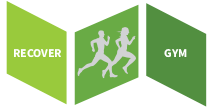The spine forms 33 vertebrae, of which the upper 24 are movable. The lower 5 vertebrae of the 24 are called the lumbar region. The lumbar vertebrae are the largest, as they must carry the vertebrae that stand on top (chest and neck vertebrae), but at the same time they must also be stable enough to keep the body without it swaying uncontrollably.
The pressure in the lower back is therefore of course many times greater than in the neck, for example, and therefore disc prolapses are also seen much more frequently here. About 95% of herniated discs occur at the lower lumbar spine, while about 4% at the cervical vertebrae , and less than 1% at the thoracic vertebral area.

Find your injury in the list below:
External impingement of the shoulder
Iskias syndrom
- Radiation down the back of the thigh, the outside and front of the lower leg, the outside and the front of the foot.
- The symptoms worsen if you get up from a sitting position, ascend the stairs or drive a car for a long time.
- The symptoms decrease if you exercise, ex. jogging or running.
Piriformis syndrome
- Pain in the lumbar part or in the buttocks.
- Radiating pain.
- The pain increases with the load.
- Pain or radiation when walking / running.
- Restlessness in the leg when resting.
- Irritation when driving a car where you can’t really find a good sitting position without it causing irritation in the buttock or leg.
Lower back pain (Lumbago)
- The pain often occurs suddenly in the event of a heavy lift or fast turning of the body, but may also occur without prior effort.
- The condition resembles neck disorders where the joints or nerves are irritated and the muscles protect the area by making a reflective contraction.
- The pain is usually located in the lumbar part and does not radiate into the legs (remember radiating may be a sign of a prolapsed disc).
- Stiffness in the lower back.
- Functional scoliosis due to muscle tension, which prevents the normal mobility of the back which triggers the pain.
- Reduced mobility.
Runner’s back
- Runner’s back: Basically, you can divide the injury into two types:
- If the injury is double-sided, the injury will most often be located in the back, where excessive curvature of the spine will usually be visible and / or back pain initiates when training begins or after training. The pain will most likely be related to strong hip stretches; e.g. in running, hence the name “Runner’s Back”.
- If the injury is unilateral, the injury will be felt in the attachment area of the groin and possibly in the bursae. It’s not strong enough to pull the back into a sway. The pain is most often provoked by heavy hip stretching and use; e.g. running, soccer and the like.
Lower cross syndrome
- Runner’s back (lower back pain).
- Baglårs skaderHamstring (back of thigh) injury.
- Injuries in the groin.
- Global back problems.
Prolapsed disc in the lower back
- Local pain at the site of the prolapse and possible radiating pain into one leg exacerbated by exertion.
- Prickling sensations the area of nerve intervention (dermatome).
- Weakness of the leg.
- Reflexes may be altered.
- Smerten forværres eller udløses af hoste eller bugpres, og kan være så kraftig, at lumbaldelen uvilkårligt holdes skævt.
- Functional failure due to direct pressure on the nerves.
Morbus Scheuermann’s Disease
- Fatigue in the spine by exertion, for example sitting in school a whole day.
- Weakness and pain associated with exertion of the back / spine
- Changes in the normal curvature of the spine.
Inflammation of the vertebrae (Modic changes)
- Pain in the back that is constant or swings up and down without disappearing.
- Pain which inhibits sleep over a long period of time.
- Pain experience is not improved by treatment with physical therapy or other types of therapy.
Growth conditional crooked back (adolescent idiopathic scoliosis)
- The shoulders are asymmetrical.
- It is difficult to stand up straight.
- If one shoulder blade is more posterior.
- The rib arch is asymmetrical.
- The flank (side of the body) has a fold on one side which is not on the other.
- If the pelvis is pushed forward, the back will be asymmetrical.
- An abnormal gait pattern.

Social Medier